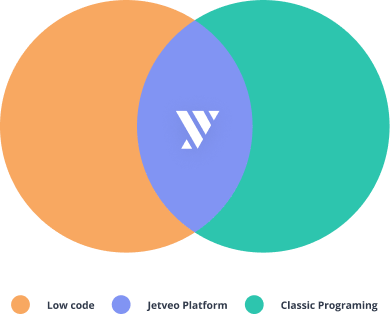Low-code Programming is Fast and Efficient
Low-code programming is considered, by many, to be the style of development that will be most popular in the very near future. It is designed to enable users to quickly and efficiently develop websites and apps.
Basically, low-code is in the sweet spot between classic programming, which requires advanced knowledge and complex coding, and no-code programming, which is based upon a drag-and-drop visual interface. Low-code programming combines the best elements of both: the flexibility and customization of classic programming and the simplicity and speed of no-code programming.
Here are some more specific details:

Classic Programming (High-code programming)
Classic Programming requires advanced knowledge and many different types of software. Developing an app from scratch can be complex. The lead programmer, whose experience comes at a not insignificant cost, must have expertise with establishing databases, establishing APIs, designing user interfaces, and implementing security.
The classic development process takes time, allocation of staff, patience, and effective in-house project management. Often the broad strokes can be straightforward, but fine-tuning and customization takes time. Testing may produce delays, particularly with customized code. Then, when it is published, ongoing maintenance and scaling require continued attention.
No-code Programming
No-code programming is a simplified version because it does not include the option to customize the business logic. You don't need years of education to build a website with a no-code platform. Nor do you need even a tiny bit of experience with programming. In fact, no-code platforms and their useability by non-programming normal people have added a new term to the tech lexicon: “gentleman programmers”.
The problem is that there are finite numbers of templates and components that can be used. If there is not a perfect fit, then there is no recourse for customization. Every business is different, so the business logic built in to the operational software needs to fit like hand in glove.
Low-code Programming is the Best of Both Worlds

Low-code is right in the middle, taking the best parts from both classic programming and no-code programming. It is faster, better, and more affordable development that allows for customization to a specific business, department, or issue.
Like a no-code platform, there is a short learning curve and building blocks quickly establish the data foundations and user interfaces that are common in all websites and apps. Templates and components save time and provide specific processes. Deployment to the internet takes one click. A what-you-see-is-what-you-get display shows the real-time version of the software. And quick iterations enable the user to keep an eye on the process, come up with new ideas, and, perhaps, make additional customizations. Novices and junior programmers can jump right in and make something without a lot of training.
On top of those basics, there is an important layer where the final, most valuable, elements are defined. C# customization enables the user to fine-tune the business logic so that each individual client has their own bespoke piece of software. That is the level of detail where the true value lies.
Jetveo is the Future of Low-code
The Jetveo platform was built to take full advantage of the low-code programming model to enable developers to generate all sorts of business applications, like CRMs, HR tools, help desks and more. It provides the fastest and most efficient way to full-company digitalization.
 DE
DE